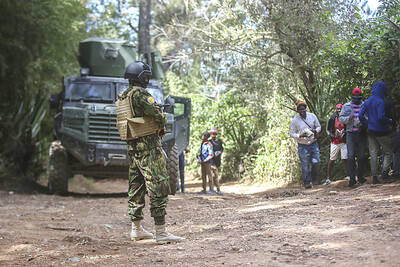Israel will encourage Jewish settlers in Gaza to leave their homes in exchange for compensation as early as this summer -- months before a Cabinet vote to approve evacuation of the settlements, according to a government document.
The government timetable, presented on Wednesday to the committee overseeing the pullout, calls for completion of the process by Sept. 30, 2005, or three months ahead of the original target date.
Settlers who refuse to leave by Sept. 1, 2005, will be forced out of their homes by the middle of the month, according to the document.

PHOTO: AP
The document was a sign of Israeli Prime Minister Ariel Sharon's determination to go ahead with the pullout, despite opposition from hard-liners who this week deprived him of his parliamentary majority and threatened to bring him down.
Also, some Cabinet opponents were won over by his pledge to bring the four stages of settlement evacuation before separate votes, but the timetable means that the votes would be meaningless.
According to the plan, 21 settlements in Gaza and four in the West Bank would be evacuated by Sept. 15, 2005, and the army would pull out of Gaza by the end of that month. The process would begin with voluntary exit by settlers, beginning in August this year, in exchange for compensation.
In Washington, Sharon adviser Zalman Shoval said the houses at the settlements would be destroyed, but the public buildings would remain.
He told the Washington Institute for Near East Policy, a private research group, that many Israelis did not want to see Palestinian flags flying from homes once occupied by Israeli Jews.
The Cabinet approved the withdrawal plan on Sunday, the first time Israel has decided in principle to remove veteran settlements from the West Bank or Gaza.
The timetable for evacuation of the 7,500 Jewish settlers and the military was put together by Israel's National Security Council.
The Sept. 30, 2005 date for completing the full withdrawal is three months ahead of the target date Sharon has mentioned. In a speech on Wednesday, he repeated his goal of ending Israel's presence in Gaza.
"Israel made a decision this week crucial to its future, a decision on the disengagement plan that will be completed by the end of 2005," he said.
Though Cabinet skeptics insisted that their vote in favor of Sharon's "unilateral disengagement" plan did not include approval of actual evacuation of settlements, the document shows that starting in November, compensation would be paid to settlers who leave their homes voluntarily in an exodus that would begin three months earlier.
The timetable mentions a Cabinet vote in February, 2005 approving evacuation of settlements, but the process would be in motion months before then. The timetable was presented at the committee meeting as an approved schedule, but it could face alterations if opposition surfaces.
Israeli officials said Wednesday's meeting reflected the prime minister's determination to push forward with his plan.
"He is as determined as can be," said the senior government official, speaking on condition of anonymity. Following the Cabinet vote, he said, the plan is "irrevocable."
The voluntary settler-evacuation period would continue until July 2005.
Entry into the settlements would be banned after Aug. 14, 2005, to stop thousands of people from going to protest or block the pullout.
Evacuation "by force" of settlers who refuse to leave on their own would begin on Sept. 1, 2005, to be completed by Sept. 15, 2005.
The second section of the timetable calls for negotiating with international organizations about issues like transferring property. The target date is October 2004.
The third section orders the military to begin preparing its withdrawal in July 2004, pulling out of Gaza between Sept. 15 2005 and Sept. 30, 2005, just after the final evacuation of the settlements.
In Gaza violence on Wednesday, a Hamas militant was killed as Israeli troops moved into Palestinian areas, surrounded a house and flattened farmland, Palestinian officials said.
Palestinian militants fired a rocket at an Israeli town from the area on Tuesday.
The military said soldiers returned fire after an anti-tank missile was fired at them.

DITCH TACTICS: Kenyan officers were on their way to rescue Haitian police stuck in a ditch suspected to have been deliberately dug by Haitian gang members A Kenyan policeman deployed in Haiti has gone missing after violent gangs attacked a group of officers on a rescue mission, a UN-backed multinational security mission said in a statement yesterday. The Kenyan officers on Tuesday were on their way to rescue Haitian police stuck in a ditch “suspected to have been deliberately dug by gangs,” the statement said, adding that “specialized teams have been deployed” to search for the missing officer. Local media outlets in Haiti reported that the officer had been killed and videos of a lifeless man clothed in Kenyan uniform were shared on social media. Gang violence has left

US Vice President J.D. Vance on Friday accused Denmark of not having done enough to protect Greenland, when he visited the strategically placed and resource-rich Danish territory coveted by US President Donald Trump. Vance made his comment during a trip to the Pituffik Space Base in northwestern Greenland, a visit viewed by Copenhagen and Nuuk as a provocation. “Our message to Denmark is very simple: You have not done a good job by the people of Greenland,” Vance told a news conference. “You have under-invested in the people of Greenland, and you have under-invested in the security architecture of this

Japan unveiled a plan on Thursday to evacuate around 120,000 residents and tourists from its southern islets near Taiwan within six days in the event of an “emergency”. The plan was put together as “the security situation surrounding our nation grows severe” and with an “emergency” in mind, the government’s crisis management office said. Exactly what that emergency might be was left unspecified in the plan but it envisages the evacuation of around 120,000 people in five Japanese islets close to Taiwan. China claims Taiwan as part of its territory and has stepped up military pressure in recent years, including

UNREST: The authorities in Turkey arrested 13 Turkish journalists in five days, deported a BBC correspondent and on Thursday arrested a reporter from Sweden Waving flags and chanting slogans, many hundreds of thousands of anti-government demonstrators on Saturday rallied in Istanbul, Turkey, in defence of democracy after the arrest of Istanbul Mayor Ekrem Imamoglu which sparked Turkey’s worst street unrest in more than a decade. Under a cloudless blue sky, vast crowds gathered in Maltepe on the Asian side of Turkey’s biggest city on the eve of the Eid al-Fitr celebration which started yesterday, marking the end of Ramadan. Ozgur Ozel, chairman of the main opposition Republican People’s Party (CHP), which organized the rally, said there were 2.2 million people in the crowd, but